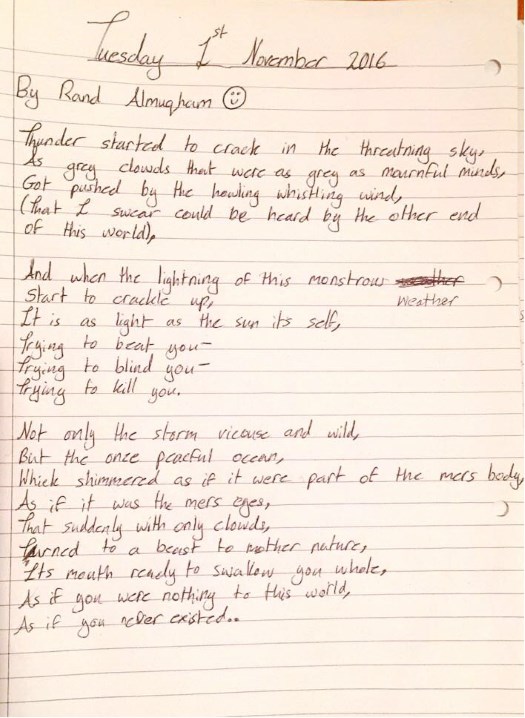Introducing Jamila
Nora Abdulaziz M. Alyahya, Saudi Arabia
Nora Abdulaziz M. Alyahya is a teacher with teaching experience in primary schools in Saudi Arabia. She is also an MA student and is developing her own online resources for primary school learners.
Menu
Introduction
Jamila’s poem
Storytelling resources for teachers
This learner story is about Jamila (a fictionalized name for the child learner), an 11-year-old child from Saudi Arabia who is currently a student of year group 7 in a secondary school in England. She moved to the UK with her parents when she was 6 years old. Her secondary school teachers evaluate her as one of the top students in her class with respect to her academic participation and achievement. Jamila has a fluent knowledge of the English language. Although Jamila speaks Arabic language fluently, yet she was particularly articulate in expressing her experience with the English language. Coming from a different cultural background, Jamila saw herself as different from her peers. When she was asked what it was like when she first joined school in England, she explained that ‘it was scary. I was confused. I thought … and everything should be English. But it wasn’t like that. Teachers were very nice. Ms.… told us to sit in a circle, she told me to introduce myself and she helped me when I needed help with the words. Teachers were asking me about Saudi Arabia and what I’ve learned there’. The child also experienced joy and enthusiasm as she was invited to share and express her cultural and social Saudi insider knowledge to the classroom whenever it was desirable, for example in international evenings at school, during religious occasions like Eid and Ramadan). It seems that this frequent contribution served as a strong motivation for Jamila, which in turn reduced her anxiety and made her keen to search, write and represent information in the English language.
In response to a question about her preferences while learning the English language, Jamila answered that she particularly enjoyed the use of storytelling in the classroom. Some of the stories Jamila was exposed to during her primary school were actually English versions of stories that she already knew during her short educational experience in Saudi Arabia. For example, she was particularly positive towards a story version of “Aladdin and The Magic Lamp”. Indeed, the enjoyable environment and positive experience Jamila found within a story-telling classroom eliminated her anxiety and led to more language development. Her enjoyment of storytelling seems to be reflected in her writing. She chose sea storm as a topic for her writing, focused on describing it and added interesting details about it. Although her writing does not follow the traditional method of story narration, yet it implicitly signifies particular events just as a story would do so.
Conversations with Jamila show that she mostly communicates with her parents and little brothers in English ‘even if my dad and mom do not speak to me in Arabic, I’d still talk to them in English’. She was also positive about the use of other languages as well in the classroom ‘I like to learn a different language because it is like a challenge and I really really wanna do it’. In school, additional opportunities were provided for Jamila to practice and learn the language. Some tasks were peculiar to educational contexts, such as stories, quizzes, plans and reading diaries, while others were similar to those experienced outside classroom and at home like different games and conversations.
The language Jamila either learnt or acquired within school was the means she used in order to reach out and connect with other people in school and beyond. It appears that storytelling provided a bridge for Jamila across the social and cultural gap. She enjoyed the way storytellers perform the story, involving young listeners and often miming the actions and words when telling the story.
Jamila’s poem shows her ability to tell a story herself, imagining the colours, sounds and feelings of a thunderstorm. It shows the connection between imaginative learning in the classroom, and ownership of the language to shape something that is distinctly and imaginatively her own.

The example of Jamila will inspire other teachers to give children imaginative chances in the class. To help them in doing so, the websites and links below have been helpful in providing both teaching activities (in the case of Spiro 2004); ideas and strategies for teachers (Grugeon and Gardner 2012), a rationale and support for storytelling as a teaching approach (British Council 2003), and examples of children themselves producing digital stories (Anderson and Macleroy 2016).
Anderson J and Macleroy V (eds) (2016) Multilingual Digital Storytelling: Engaging Creatively and Critically with Literacy. London: Routledge.
British Council, BBC Teaching English (2003) Storytelling – Benefits and Tips. Available at www.teachingenglish.org.uk/article/storytelling-benefits-tips
[accessed 12 November 2016]
Fitzgibbon H B and Wilhelm K H (1998) Storytelling in ESL EFL Classrooms. TESL Reporter. 31(2), 21-31
Grugeon E and Gardner P (2012) The Art of Storytelling for Teachers and Pupils: Using Stories to Develop Literacy in Primary Classrooms. London: Routledge.
Spiro J (2004) Creative Poetry Writing. Oxford: Oxford University Press.

Please check the Methodology & Language for Primary course at Pilgrims website.


|